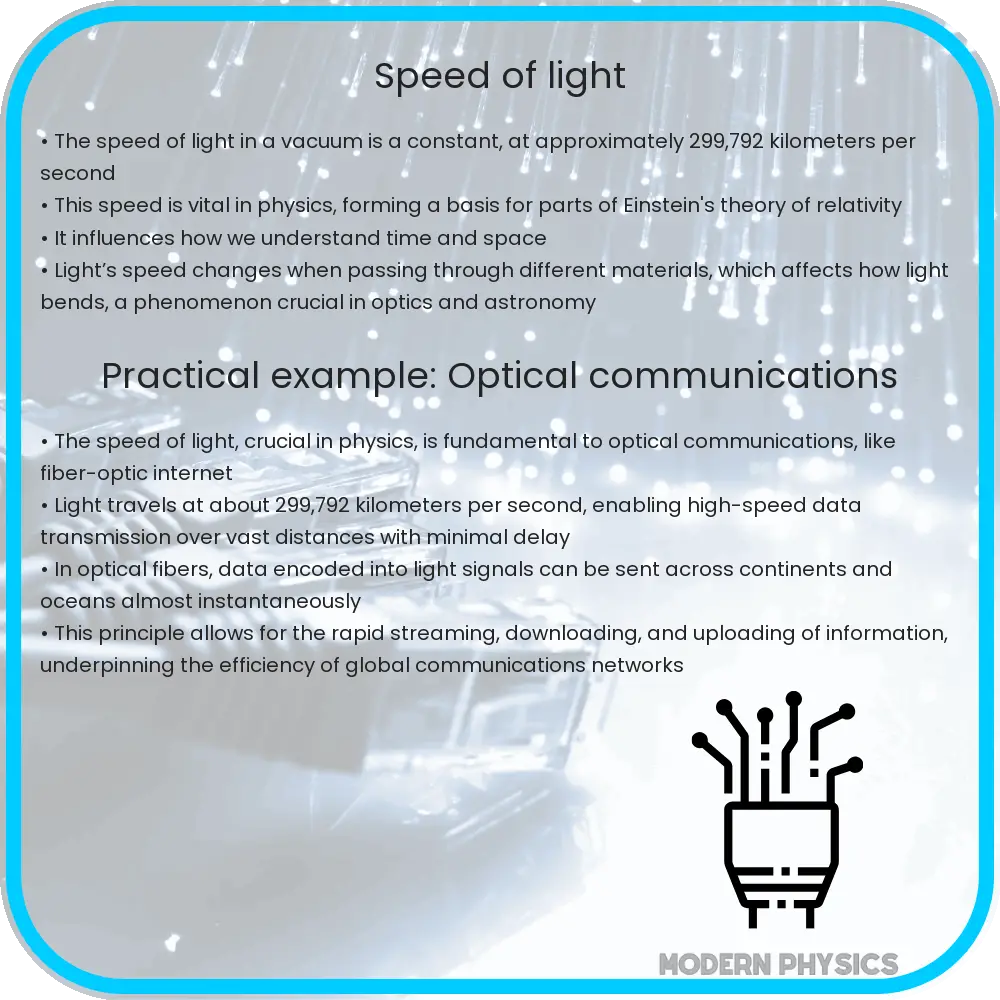Explore the role of light speed in Einstein’s Special Relativity, its impact on modern physics, and technological advancements it inspired.

Understanding the Speed of Light in the Realm of Special Relativity
The concept of the speed of light is pivotal in the field of physics, particularly in the theory of Special Relativity, proposed by Albert Einstein in 1905. This theory revolutionized our understanding of space, time, and how they interact with the velocity of light. The speed of light in vacuum, commonly denoted as ‘c’, is approximately 299,792,458 meters per second. This constant is not just a value; it represents a fundamental limit in our universe.
The Role of ‘c’ in Special Relativity
Einstein’s theory of Special Relativity brought about a paradigm shift in our comprehension of the physical world. One of the theory’s core principles is that the speed of light in vacuum is constant and independent of the observer’s motion. This principle leads to several groundbreaking conclusions:
- Time Dilation: Time appears to slow down for an object moving at a high velocity compared to a stationary observer. This effect is particularly noticeable at speeds close to the speed of light.
- Length Contraction: Objects in motion are observed to contract in the direction of motion when they approach the speed of light.
- Mass-Energy Equivalence: This is encapsulated in the famous equation E = mc2, which shows that mass (m) and energy (E) are interchangeable, with ‘c’ acting as the conversion factor.
Constants and the Speed of Light
The speed of light ‘c’ is not just a speed limit; it is also a fundamental constant in various physical laws. It plays a crucial role in electromagnetic theory, quantified in Maxwell’s equations, and in the understanding of the nature of light and other electromagnetic phenomena. The constant ‘c’ ties together space and time in the fabric of the universe, leading to the concept of spacetime – a single, four-dimensional continuum.
Moreover, the constancy of the speed of light leads to fascinating implications in cosmology and astrophysics. It sets a limit on how fast information can travel and hence affects how we perceive distant objects in the universe. Due to this finite speed, when we look at distant galaxies, we are essentially looking back in time.
Special Relativity and the speed of light not only provide insights into the vast cosmos but also into the nature of the tiny quantum world. The unification of these scales remains one of the biggest challenges and most intriguing aspects of modern physics.
The Implications of Light Speed on Modern Physics
Albert Einstein’s Special Relativity theory, with the speed of light as a cornerstone, has profound implications in modern physics. It paved the way for General Relativity, Einstein’s theory of gravitation, where he proposed that gravity is not a force but a curvature of spacetime caused by mass. In this theory, the speed of light again plays a crucial role, influencing how gravity affects time and space.
Additionally, the speed of light has significant implications in quantum mechanics, particularly in the realm of quantum entanglement. While no information can travel faster than light, quantum entanglement suggests that particles can be correlated in such a way that the state of one instantaneously affects the state of another, regardless of the distance. This phenomenon challenges our understanding of the speed of light as an ultimate speed limit, pushing the boundaries of quantum physics and relativity.
Technological Applications and Future Research
The principles derived from the speed of light have led to numerous technological advancements. Global Positioning Systems (GPS), for instance, rely on precise time measurements, which are corrected for the effects of Special Relativity. Similarly, technologies such as nuclear power and medical imaging techniques like PET scans are applications of Einstein’s mass-energy equivalence principle.
Future research continues to delve into the mysteries of light speed. Scientists are exploring the possibilities of faster-than-light travel and its implications on causality and time travel. Additionally, research in quantum mechanics and the quest for a unified theory that reconciles quantum mechanics with general relativity may further illuminate the nature of light speed in the universe.
Conclusion
The speed of light is more than a physical constant; it is a key to understanding the universe. Its role in Special Relativity has changed our perception of time, space, and matter. From the macroscopic scale of the cosmos to the microscopic realm of quantum particles, the constant speed of light integrates into the very fabric of reality, guiding the principles of modern physics. As we continue to explore and challenge these concepts, the speed of light remains a beacon, illuminating our path towards greater understanding and technological advancement. Its significance extends beyond theoretical physics, impacting practical applications and continually inspiring the quest for knowledge in the uncharted territories of science.
